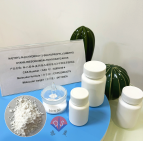Chinese VersionChina Suppliers > Hubei new DE sheng material science and technology co., LTD. > In what aspects can the chromogenic substrate ADOS 82692-96-4 be applied?
- Search Product
-
-
- Region :China/Hubei
- Tel : +86-18971041571
- Fax :
- Email :vickyzhao@whdschem.com
- URL :
- Add :Guanggu United Science and Technology City C8, Ezhou City, Hubei Province
- Details for In what aspects can the chromogenic substrate ADOS 82692-96-4 be applied?
-
In what aspects can the chromogenic substrate ADOS 82692-96-4 be applied?
Category : Other Chemicals/Others

CAS NO : 82692-96-4 EC NO : MF : C12H18NNaO5S·2(H2O) MW : 347.36 Specification : White Powder Packing : 500g/bottle Product description : The color substrate ADOS has a good crystal shape, high purity, and a CAS of 82692-96-4. Compared with traditional color substrates, it has higher sensitivity and specificity, and is therefore widely used in diagnostic detection and biochemical experiments. Especially in gene expression analysis, protein purification, drug screening, etc., it has played a unique advantage. Below, we will focus on introducing the application of the chromogenic substrate ADOS from these aspects. 1、 Gene expression analysis experiment The chromogenic substrate ADOS can be used to measure the expression levels of important proteins related to gene expression, such as transcription factors and RNA binding proteins. Specifically, it involves mixing the chromogenic substrate ADOS with the sample to be tested, and quantitatively measuring the expression level of the target protein by measuring the intensity of the chromogenic signal in the sample. The advantage of this method is that it is easy to operate, does not require the use of other complex instruments and equipment, and has high accuracy and repeatability. 2、 Protein purification experiment The chromogenic substrate ADOS can be used to identify and isolate proteins with specific fluorescence properties, providing basic data support for subsequent research. In the process of protein purification, the chromogenic substrate ADOS can bind to the target protein to form a chromogenic complex, and its distribution in the sample can be observed through colorimetry. This method is very fast and accurate in identifying target proteins, avoiding the influence of other factors. 3、 Drug screening experiment The chromogenic substrate ADOS can be used to evaluate the efficacy and toxic side effects of new drugs in experiments, providing strong support for drug development. During the drug screening process, the chromogenic substrate ADOS can bind to the tested protein and evaluate the effectiveness of the drug by measuring changes in the chromogenic intensity in the sample. Meanwhile, ADOS can also be used to evaluate the toxic side effects of drugs, for example, by observing changes in the absorbance of the sample to determine whether the drug will cause damage to cells. This method has high sensitivity and can provide data in a short period of time to help experimenters make judgments. With the continuous development and improvement of technology, the chromogenic substrate ADOS is a reagent with broad application prospects, and it is believed that more and more people will use it in the future. As a manufacturer of the new Trinder's reagent ADOS, Desheng's products not only have stable performance, but also have an absorbance wavelength of 542nm and high reaction sensitivity, making them the preferred reagent in various experiments. If you also have similar needs, please click on the website to inquire about details and purchase! Uses : The New trinder's reagent Synonyms : N-Ethyl-N-(2-hydroxy-3-sulfopropyl)-3-methoxyaniline sodium salt dihydrate;N-Ethyl-N-(2-hydroxy-3-sulfopropyl)-3-methoxyaniline, sodium salt, dihydrate; Molecular Structure : 
- more>>Other Products
-
- • Biological buffer 3- [N, N-di (hydroxyethyl) amino] -2-hydroxypropanesulfonic acid DIPSO
- • Luminol Sodium Salt
- • 4-Aminophthalhydrazide
- • acridinium ester DMAE-NHS
- • acridinium ester NSP-DMAE-NHS
- • Acridine hydrochloride NSP-SA
- • Acridine hydrochloride NSP-SA-NHS
- • NSP-SA-ADH
- • acridinium ester ME-DMAE-NHS TOOS; 3-(N-Ethyl-3-Methylanilino)-2-Hydroxypropanesulfonic Acid Sodium Salt
- • TOPS; Sodium 3-(N-Ethyl-3-Methylanilino)Propanesulfonate; N-Ethyl-N-Sulfopropyl-M-Toluidine Sodium Salt
- • ADOS Sodium 3-(Ethyl(3-Methoxyphenyl)Amino)-2-Hydroxypropane-1-Sulfonate Dihydrate
- • ADPS N-Ethyl-N-(3-Sulfopropyl)-3-Methoxyaniline Sodium Salt
- • ALPS N-Ethyl-N-(3-Sulfopropyl)Aniline Sodium Salt; Sodium 3-(Ethyl(Phenyl)Amino)Propane-1-Sulfonate; Sodium
- • DAOS; Sodium 3-((3,5-Dimethoxyphenyl)(Ethyl)Amino)-2-Hydroxypropane-1-Sulfonate
- • HDAOS; N-(2-Hydroxy-3-Sulfopropyl)-3,5-Dimethoxyaniline Sodium Salt
- • MADB N,N-Bis(4-Sulfobutyl)-3,5-Dimethylaniline Disodium Salt
- • MAOS N-Ethyl-N-(2-Hydroxy-3-Sulfopropyl)-3,5-Dimethylaniline Sodium Salt Monohydrate
- • DAB 3,3',4,4'-Biphenyltetramine Tetrahydrochloride